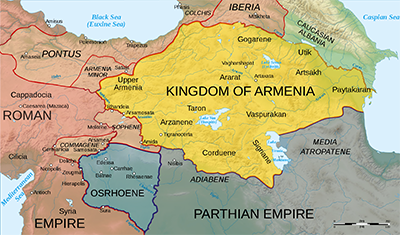King Mithridates VI of Pontus
Mithridates VI was King of Pontus and an enemy of the Roman Republic during the 1st Century B.C. 
The first King Mithridates had founded Pontus in 301 B.C. The fifth king of that name had helped Rome prosecute the Third Punic War. That king was married to Laodice VI, and their son became King Mithridates VI. He was born in 132 B.C. in Sinope and grew up in the royal household, with all of its trappings of wealth and a good education at his disposal. His father died when the boy was 11. The king was known to have been poisoned, and some suspected that his wife had played a part in the assassination. As a result, the newly minted Mithridates was technically king but his mother played the role of regent. He had a younger brother, named Mithridates Chrestus, and their mother wanted the younger Mithridates to be king. Fearing for his life, the young king left the royal court and went into hiding. The boy also began to take small doses of poison, in hopes of preventing his own assassination by that means. In 116 B.C., the young king, also known as Eupator, returned to the royal court and seized control. He had both his mother and his brother imprisoned; both later died. He then married his younger sister, who was named after their mother, in order to maintain the royal bloodline; they had several children together. (The young king claimed descent from both Darius the Great and Alexander the Great and saw himself following in the latter's footsteps as the uniter of East and West.) Emboldened, Mithridates turned to extending his influence beyond the Pontus borders. His first target was Colchis, east of the Black Sea. He then conquered the Scythians and trained his focus on Bithynia. The king of that land at that time was Nicomedes III, and he called on the leaders of the Roman Republic to help him. Mithridates had cemented an alliance with Armenia by sending his own daughter, Cleopatra, to marry Tigranes the Great, the Armenian king. In return, Tigranes conquered Cappadocia. Rome at the time was busy with other wars but still managed to send a force led by Lucius Cornelius Sulla to put the deposed Cappadocian king, Ariobarzanes, back on the throne. A bit later on, Nicomedes III of Bithnyia died, and Mithridates had enough influence to install his own man on the Bithynian throne, while at the same time knock Ariobarzanes back off the Cappadocian throne and taking it for himself. 
A determined Rome sent another force, led by the consul Manius Aquillius, to sort things out. The forces of Pontus made quick work of the Roman force and then King Mithridates (left) orchestrated a large-scale uprising against Rome known as the Asiatic Vespers. On one day in 89 B.C. or 88 B.C. (historians differ on which), common people in areas controlled by Rome rose up and slew any Romans or Italians they could find. Enticements offered by Mithridates included freedom to slaves who killed their "owners" and debt relief for those who killed their creditors. Tens of thousands of people died on this one day in many cities and towns. Rome responded in 87 B.C. by again sending in Sulla, this time at the head of five legions. The Romans defeated Mithridates's general, Archelaus, in a series of battles that resulted in the Roman reoccupation of Greece. Both Sulla and Mithridates encountered problems at home and, in 84 B.C., concluded a peace treaty that ended what the Romans called the First Mithridatic War. Left behind to keep the peace in Anatolia was the Roman general Lucius Licinius Murena. The treaty didn't exactly prevent Mithridates from rebuilding his army, and the king did so, provoking a response from Murena, who started the Second Mithridatic War in 83 B.C. The Roman general invaded Pontus but was routed and retreated. Mithridates chose to continue to scheme and rebuild, rather than retaliate, and another treaty ended another war between Pontus and Rome. The next decade saw no war between the two powers but plenty of intrigue. Mithridates shored up his base by cementing alliances with Egypt and the Cilician pirates. Some historians say that Mithridates even reached out to the Roman slave revolt leader Spartacus in order to needle Rome. King Nicomedes IV of Bithynia died about 75 B.C. and left his kingdom to Rome. As before, Mithridates put his own choice of king on the Bithynian throne. Rome insisted that Mithridates keep out of Bithynian affairs, he refused, and the Third Mithridatic War began. Again, Rome had superior numbers and strategy, as Lucius Licinius Lucullus and his forces drove Mithridates out of Bithynia, back into Pontus, and then into Armenia. Tigranes was still ruling that land, and he and Mithridates still had an understanding. Tigranes refused to hand over his friend, and Rome invaded Armenia. Roman might proved the better again, and Rome conquered Armenia. Both Mithridates and Tigranes escaped, however. Rome at this time recalled Lucullus. Replacing him at the head of the Roman forces in the area was Pompey the Great, who wasted no time in routing the Cilician pirates. Mithridates took the opportunity to reclaim his kingdom, but his victory was brief, as Pompey entered into an alliance with King Phraates III of Parthia so that that king would march on Armenia, depriving Mithridates of any aid from Tigranes and his forces, while Pompey himself marched on Pontus. A defeated Mithridates fled before the Roman advance, imploring his oldest son, Machares, to help him. The latter had thrown in his lot with Rome and refused to help his father regain his throne. The same proved true of the second son, Pharnaces. Mithridates, having few options other than surrendering, chose to take his own life. He died in 63 B.C. |
|
Social Studies for Kids
copyright 2002–2025
David White




